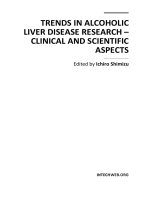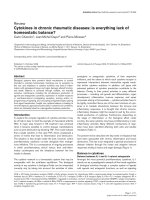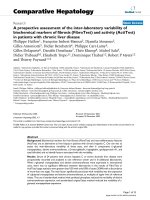In situ distribution of enolase isozymes in chronic liver disease
Bạn đang xem bản rút gọn của tài liệu. Xem và tải ngay bản đầy đủ của tài liệu tại đây (1.86 MB, 6 trang )
0002-9270/89/8406-0601
Vol.84. No. 6. 1989
THE AMERICAN JOURNAI OV GASTROKNTEROLOGV
Primed in U.S.A.
Copyri^t © 1989 by Am. CoU. of Gastroenterology
In Situ Distribution of Enolase Isozymes in
Chronic Liver Disease
Yoshihide Fukuda, M.D., Yuuji Miyazawa, M.D., Masami Imoto, M.D., Yasuo Koyama, M.D.,
Isao Nakano, M.D., Hiroshi Nagura, M.D., and Kanefusa Kato, M.D.
Second Department of Internal Medicine and Insitulefor Disease Mechanism and Control. Nagoya University School of
Medicine, Nagoya, and Department of Biochemistry. Institute for Developmental Research. Aichi Prefectural Colony.
kasugai. Japan
Liver biopsy specimens with or without chronic liver
diseases were examined immunohistochemically to determine the distrihution of enolase isozymes (a, 0, and
y). In normal liver, a-enolase was positively stained in
almost all hepatocytes and bile duct cells, p- and yenolases were localized in hepatocytes and bile duct
cells, respectively. Electron microscopic studies revealed that Kupffer cells and sinusoidal endotbelial cells
had both a- and 7-enolases. In chronic active hepatitis
and cirrhosis, proliferated biliary ductular cells had
both a- and -y-enolases, but did not express /?-enoIase.
This is almost the same localization pattern of enolase
isozymes as in preexisting bile duct cells. Y-Enolase
was detected in some hepatocytes in eight of 12 cases
with chronic active hepatitis and six of 12 cases with
cirrhosis. These hepatocytes were small, showed a cobblestone pattern, and binucleate cells were frequent. On
the other hand, rosette-formed hepatocytes adjacent to
a regenerating bulging lobule were not stained for 7enolase. These results suggest that regenerating hepatocytes have 7-enolase and that, with maturation, hepatocytes lose it.
for cell differentiation (2, 6). Niimi et al. (7) reported
altered distribution of enolase isozymes in the bronchial
mucosa with proliferated and metaplastie lesions. Hepatocellular regeneration and biliary ductular proliferation are common phenomena in chronic active hepatitis and cirrhosis. For these conditions, however, the
isozyme distribution patterns of enolase have not yet
been reported.
The present study clarifies the immunohistochemical
distribution of enolase isozymes in various cells ofthe
liver with or without chronic liver diseases, and discusses the biological significance ofthe appearance and
disappearance of enolase isozymes in hepatocytes and
bile duct cells in diseased liver.
MATERIALS AND METHODS
Tissue specimens
Tissue specimens were obtained by either needle
biopsy or surgical wedge resection from 24 patients
with chronic active hepatitis (eight cases of hepatitis B
and four cases of non-A, non-B hepatitis) and nonalcoholic cirrhosis (12 cases). Histologically normal Hver
tissues were obtained by biopsy for diagnostic purpose
from five patients undergoing surgery for abdominal
tumors. A portion of each specimen was immediately
fixed in periodate-lysine-4% paraformaldehyde (8),
then washed in increasing concentrations of sucrose in
phosphate-buffered saline (PBS). Thefixedtissues were
embedded in Tissue-Tek OCT compound (Miles Pharmaceutical, Naperville, IL) and frozen in ethanol with
dry ice. They were cut into sections 6 tixn thick on a
cryostat microtome.
INTRODUCTION
Enolase is a glycolytic enzyme distributed in all mammalian cells (1). It is a dimer composed of three distinct
subunits, a, /3, and y. «-Enolase is the major form in
the liver. Small amounts of ^- and 7-enolases are also
detectable in the liver {2, 3). The /3-subunit (/3-enolase)
is distributed mainly in the skeletal muscle as a/3 and
/3i3 forms, whereas the 7-subunit (7-enolase) is present
predominantly in the brain and neuroendocrine cells
as «7 and 77 forms (2). We previously proposed that
the quantification of these isozymes in serum is useful
as a disease marker for patients with myocardial infarction, myopathy (4), and neuroblastoma (5).
In addition to practical use as a diagnostic tool,
enolase isozymes have received attention as markers
Antibodies
Antibodies specific to «-. )3-, and 7-subunits of human enolase were raised in New Zealand white rabbits
and purified as reported previously (4, 9). The Fab'
fragments of the purified antibody IgG were labeled
with horseradish peroxidase (10). In control experiments, the Fab' fragments of non-immune rabbit IgG
were also labeled with horseradish peroxidase.
Received Sept. 22. 1988; revised Feb. 9. 1989; accepted Feb. 22.
1989.
601
602
Vol.84. No. 6.1989
FVKVDA etal.
Immunoh istochem istry
The direct peroxidase-labeled antibody method was
used for the immunohistochemical staining, with minor
modifications (11),
Cryostat sections for light microscopy were treated
with 100% methanol containing 0.1% hydrogen peroxide for 20 min to inactivate endogenous peroxidase.
Sections were reacted with the peroxidase-labeled antibody for 16 h at 4°C, then dipped in 0,025% diaminobenzidine (DAB) solution containing 10 mM sodium
azide for 5 min. and counterstained with methyl green.
Cryostat sections adjacent to those taken for light
microscopy were treated similarly through the antibody
incubation steps, and the sections were postfixed in 1 %
glutaraldehyde in PBS. The postfixed sections were
washed and incubated with 0.025% DAB solution without hydrogen peroxide for 15 min, and then with
0.025% DAB solution containing 10 mM hydrogen
peroxide for 10 min. The sections were washed, reacted
with 2% osmium tetroxide in PBS, dehydrated in
graded ethanols, and embedded in Epon. Ultrathin
sections were viewed with a Hitachi H-300 electron
microscope.
RESULTS
Light microscopy
Histologically normal liver. a-Enolase was found in
almost all hepatocytes and epithelial cells of hile ductules and interlobular and septal bile ducts in all five
cases. The intensity of the staining of this antigen in
bile duct cells was greater than that in hepatocytes (Fig.
1). Zonal distribution in the hepatic lobules was not
found. |3-Enolase was positively stained in hepatocytes,
but was not detected in epithelial cells of bile ducts in
various sizes. It was more strongly stained in hepatocytes located in zone 1 than in zone 3 (Fig. 2). The ysubunit was not detected in hepatocytes, except one
case which showed a weakly positive stain of a few
hepatocytes. This form of enolase was identified for the
most part in bile duct cells and intrahepatic nerve fibers
(Fig. 3), as previously reported (12, 13). Enolase isozymes of sinusoidal lining cells were difficult to detect
at the light microscopic level.
The results of the distribution of the isozymes in
various cells are summarized in Table 1.
Chronic active hepatitis and cirrhosis. Staining patterns of a- and ^-enolases were almost the same in
chronic active hepatitis and cirrhosis as in normal liver
tissues. Biliary ductular proliferation was found in liver
tissues from the patients with chronic active hepatitis
and cirrhosis, a- and 7-enolases were positive in these
proliferated biliary ductular cells, whereas /3-enolase was
completely negative (Figs. 4 and 5).
Distribution of 7-enolase was altered in chronic liver
Figs, i-3, Immunoperoxidase staining for a-enolase {Fig. I), 0enolase {Fi};. 2) and 7-enolase l,Fi,^. 3) in normal liver. «-EnoIase is
positive in hepatocytes and bile duct cells (arrowheads). /j-Enolase is
positive in hepatocytes. but negative in bile duct cells. 7-Enolase is
seen in bile duct cells (wrrtnv/icaJ) and nerve fibers (tJ/row.v). (xl45).
TABLE I
Distribution of Three Enotase Isozymes in Various Cells of Normal
Liver
Hepatocyte
Bile duct cell
Kupffer cell
Endothelial cell
Nerve fiber
+
+
+
+
-
+
—
-
-*
+
+
+
+
* One case showed weakly positive staining of a few hepatocytes.
disease, ln six of eight cases with hepatitis B, two of
four cases with non-A, non-B hepatitis, and six of 12
cases with cirrhosis, 7-enoiase was stained in hepatocytes (Table 2). Hematoxylin and eosin staining re-
ENOLASE ISOZYMES IN LIVER DISEASE
June 1989
603
cytes were generally small and showed a cobblestone
arrangement. Binucleate cells were sometimes detected
in the lobule. In contrast, rosette-formed hepatocytes
neighboring these bulging lobules lacked 7-enoIase (Fig.
7). The intensity ofthe 7-enolase staining varied among
pseudolobules in cirrhotic livers.
\
Control stainings
No reaction was observed in the sections treated with
the horseradish peroxidase-labeled non-immune rabbit
Fab' fragments.
Electron microscopy
Intraceliular localizations of enolase isozymes in hepatocytes and bile duct cells were almost the same. The
isozyme was detected electron microscopically in free
and membrane-bound ribosomes and the cytoplasm
(Fig. 8).
Both a- and 7-enolases were detected in Kupffer cells
and sinusoidal endothelial cells, whereas ^-enolase was
not demonstrated in these cells (Fig. 9). Nerve fibers
Figs. 4 and 5. Immunoperoxidase staining for o-enolase {Fi}>. 4)
and /5-cnolase (Fig. 5) in chronic active hepatitis. Both enolases are
seen in hepatocytes. t»-Eno!ase is also positive in proliferated biliary
ductular cells {arrowheads), but 0 is negative in these cells. Adjoining
sections (X145).
TABLE 2
Distribution ofy-Subunil in Hepatocytes*
Group
Normal liver
CAHB
CAH NANB
Cirrhosis
No. of
5
8
4
12
Degree of Reactivity
+
+
-
0
6
1
1
2
2
4
1
0
I
6
FIG. 6. Histology of a patient with chronic active hepatitis. Regenerating hepatocytes show a cobblestone appearance in the right half
of the photograph. In the left half, damages hepatocytes are seen
grouped in rosettes. Hematoxylin and eosin, xl 15,
* -f, hepatocytes positive; ±, some weakly positive cells; - , aimost
all hepatocytes negative; CAH B, chronic active hepatitis B; CAH
NANB, chronic active ncn-A, non-B hepatitis.
vealed irregular and non-uniform distribution of necrosis, inflammation, and regeneration from one lobule to
the next (Fig. 6). Regenerating hepatocytes., showing a
cobblestone appearance with thickening ofthe liver-cell
plates, were small in size and lacked lipofuscin. Sometimes these grouped cells compressed the adjacent liver
tissue. In the serial sections, 7-enoiase-positive hepato-
FIG. 7. Imtnunoperoxidase staining for 7-enolase in chronic active hepatitis. y-Enolase is stained in regenerating hepatocytes In the
right side ofthe photograph, whereas it is negative in neighboring
hepatocytes (xl 15).
604
Vol. 84. No. 6,1989
FUKUDA et al.
*^^^B
Fici. 8. rt-Enolase is distributed m free (*) and bound (arrowhead)
ribosomes, and in the cjloplasm of proliferated biliary ductular cells
(x9,7OO).
/?-eno!ase predominate over 7-enolase in normal liver
(2).
In diseased liver, our most important fmding was
that 7-enoIase was often present in hepatocytes. Viral
hepatitis is characterized pathologically by three major
morphological components: cytologic damage, inflammatory reaction, and hepatocellular regeneration. In
chronic iiver disease, these reactions vary considerably
from one lobule to the next, whereas they are generally
uniform both among lobuies and inside the lobule in
acute hepatitis (14). 7-Enolase-positive hepatocytes had
morphologic features of regeneration—that is, cobblestone configuration and obscure cell plates (15). These
features contrasted with those of damaged hepatocytes,
which were grouped in rosettes and were negative for
7-enoIase. Thus, 7-enoIase may be a marker of regenerating hepatocytes.
The clinical applicability of immunohistochemical
localization of enolase isozymes remains to be established. However, we speculate tbat it could be used as
a marker of the regenerating capability of hepatocytes
after toxic or viral injury to the Hver, or ofthe degree
of activity of viral hepatitis.
ACKNOWLEDGMENT
This study was supported in part by Grant-in-Aid for
Encouragement of Young Scientists ofthe Ministry of
Education, Science, and Culture of Japan.
Reprint requests: Yoshihide Fukuda, M.D.. Second Department
of Internal Medicine. Nagoya University School of Medicine, 65
Tsunimai-cho, Showa-ku. Nagoya 466, Japan.
FiCi. 9. /^-Enolase is stained in ribosomes of the hepatocyte (//),
but not demonstrated in the endothelial cell (£) or the Kupffer cell
(A')(x6.650).
showed diffuse staining of 7-enoiase in their axons.
These results are summarized in Table I.
DISCUSSION
We describe, immunohistochemically., the cellular
distribution of the various isozymes of enolase in normal human Hver and in chronic active hepatitis and
nonalcoholic cirrhosis. In normal liver, we found aenolase widely distributed in hepatocytes, biliary ductular cells, Kupffer cells, and endothelial cells; /3-enolase
was present only in hepatocytes, and 7-enolase in biliary ductular cells and sinusoidal lining cells. In agreement with these observations, previous work from our
laboratory found ^-enolase in normal biliary epithelial
cells (12). Thus, the immunohistologic distribution of
the enolase isozymes corresponds roughly with biochemical analyses that have found that a-enolase and
REFERENCES
1. Rider CC, Taylor CB. Enolase isoenzymes in rat tissue: Electrophoretic, chromatographic. immunological and kinetic properties. Biochim Biophys Acta 1974:365:285-300.
2. Taylor CB, Royds JA, Parsons MA, et al. Diagnostic aspects of
enolase isozymes. In: Rattazzi MC. ed. Isozymes: Current topics
in biological and medical research, vol 11. Medical and other
applications. New York: Alan R. Liss. 1983:95-119.
3. Kato K, Ishiguro V. Ariyoshi Y. Enolase isozymes as disease
markers: Distribution of three enolase subunits (a, ,8, and 7) in
various human tissues. Dis Marker 1983; 1:213-20.
4. Kato K, Okagawa Y. Suzuki F. et ai. Immunoassay of human
muscle enolase subunit in serum: A novel marker antigen for
muscle disease. Clin Chim Acta 1983; 131:75-85
5. Ishiguro Y. Kato K, Shimizu A. et al. High levels of immunoreactive nervous system-specific enolase in sera of patients with
neuroblastoma. Clin Chim Acta 1982; 121:173-80.
6. Shinohara H. Semba R. Kato K. et al. Immunohistoch .mical
localization of 7-enoIase in early human embryos. Brain Res
l986;382:33-8.
7. Niimi T. lmaizumi M, Abe T, et al. Immunohistochemical
characteristics of proliferative and metaplastic lesions in bronchial mucosa. Am J Clin Pathol 1987:88:545-51.
8. McLean IM. Nakane PK. Periodate-lysine-paraformaldehyde fixative: A new fixation for immunoelectron microscopy. J Histochem Cytochem 1974;22:1077-83.
9. Kato K, Asai R, Shimizu A, et al. Immunoassays of three enolase
June 1989
isozymes in human serum and in blood cells. Gin Chim Acta
1983; 127:353-63.
10. Wilson MB. Nakane PK. Recent development in the periodate
method of conjugating horseradish peroxidase (HRPO) to antibodies. In: Knapp W. ed. Immunofluorescence and related staining techniques. Amsterdam: Elsevier. 1978:215-24.
11. Fukuda Y, Nagura H. Imoto M. et al. Immunohistochemical
studies on structural changes of the hepatic lobules in chronic
liver diseases. Am J Gastroenterol 1986;8I:1149-55.
12. Haimoto H, Takahashi Y, Koshikawa T. et al. Immunohisto-
ENOLASE ISOZYMES IN LIVER DISEASE
605
chemical localization of 7-enolase in normal human tissues other
than nervous and neuroendocrine tissues. I.^b Invest
l985;52:257-63.
13. Miyazawa Y, Eukuda Y. Imoto M, et al. Immunohistochemical
studies on the distribution of nerve fibers in chronic liver diseases.
Am J Gastroenterol I988;83:1108-14.
14. Peters RL. Viral hepatitis: A pathologic spectrum. Am J Med Sci
1975;27O:I7-31.
15. Scheuer PJ. Liver biopsy interpretation, 3rd ed. London: Bailliere
Tindall, 1980.









